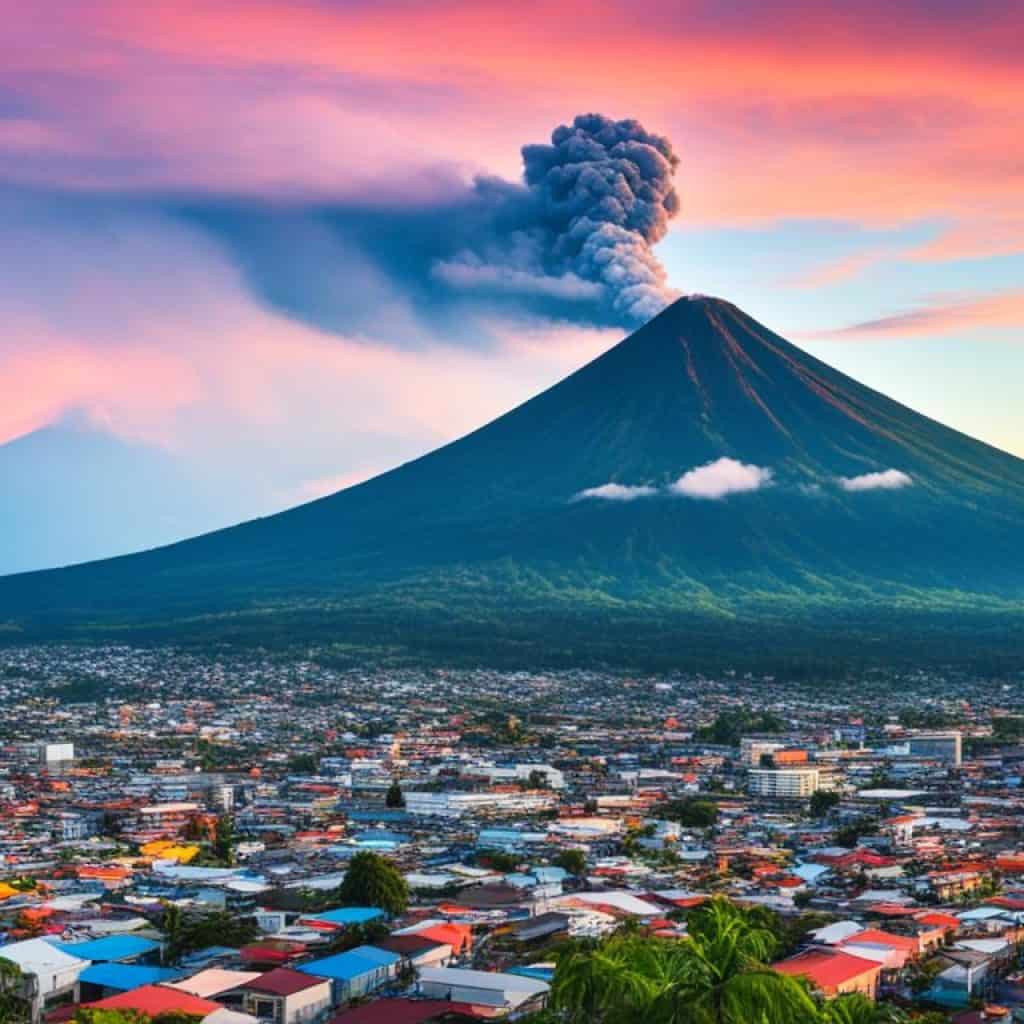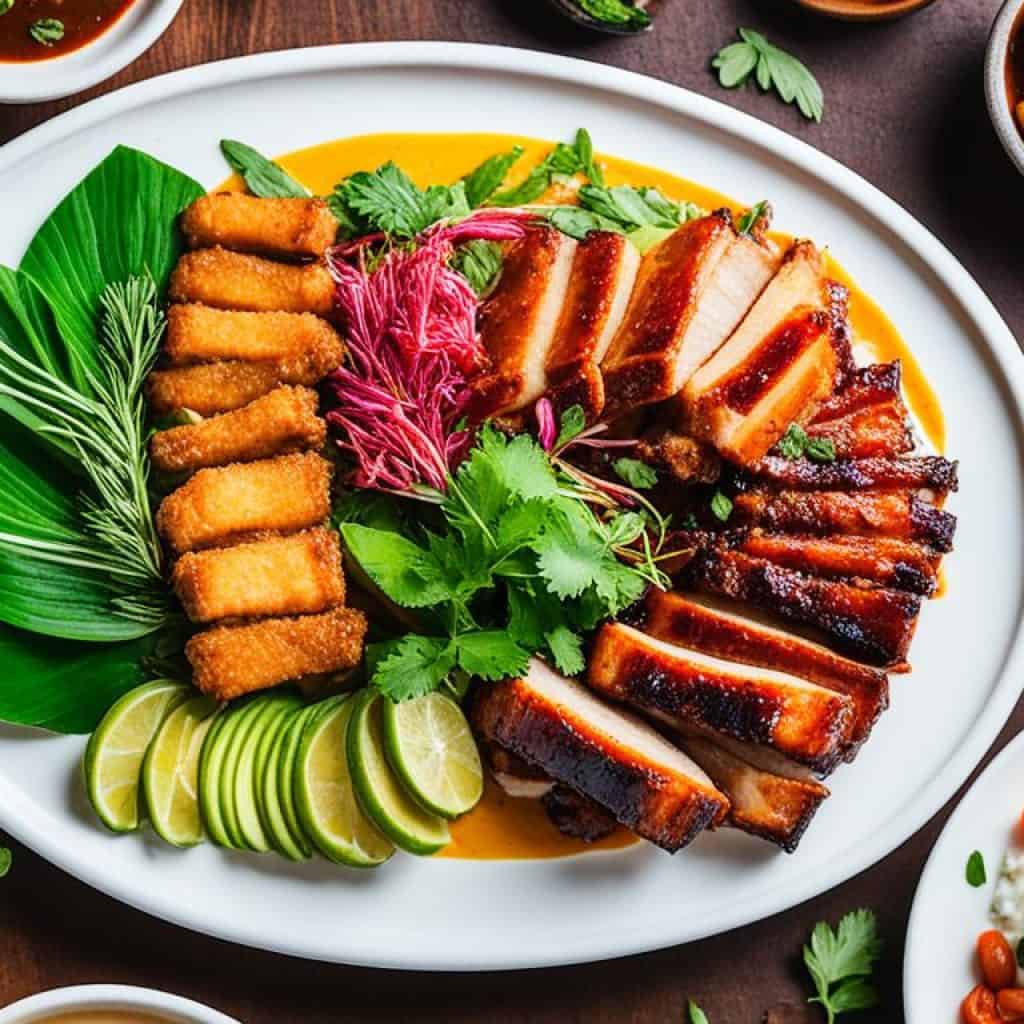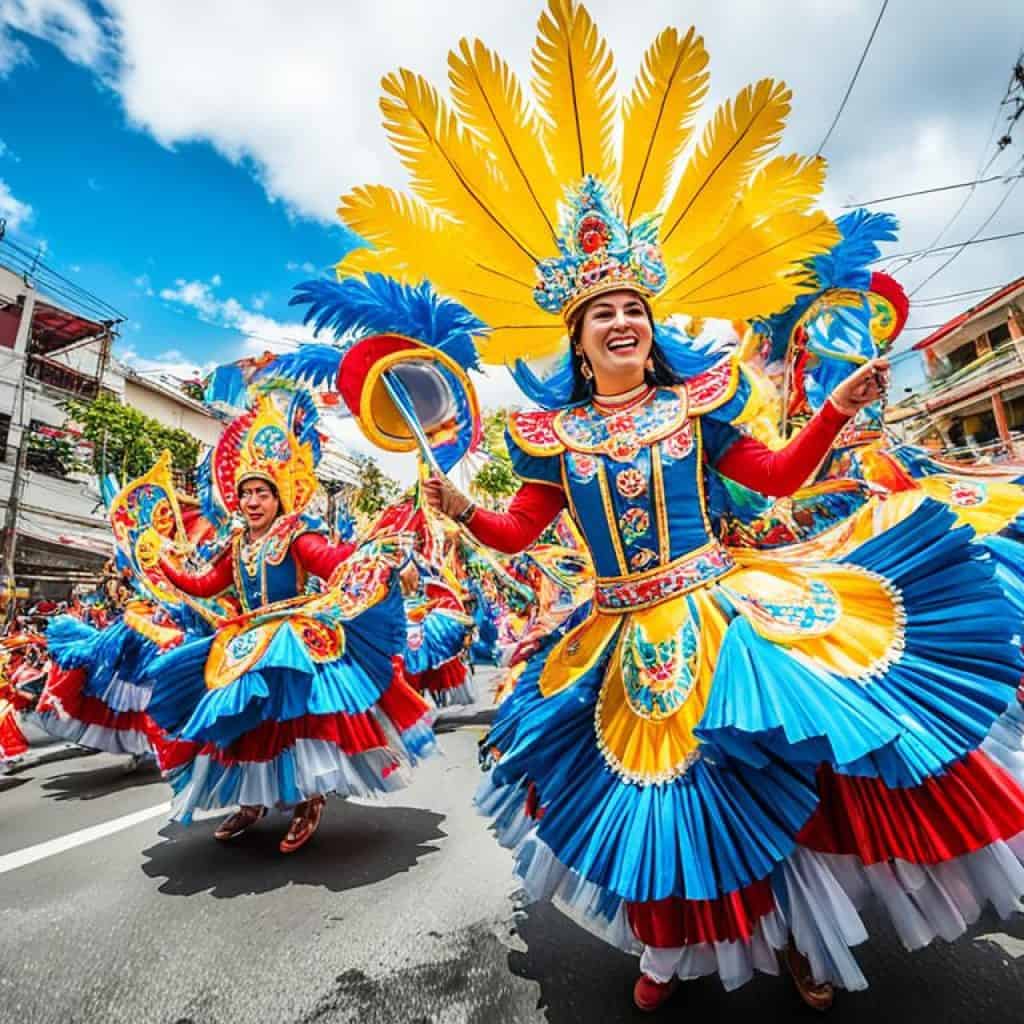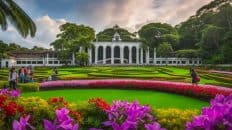Have you ever wondered why the Philippines is considered one of the best places to explore? Is it the stunning natural landscapes, the rich and vibrant culture, or perhaps something more? Join us on a journey through the enchanting beauty and captivating culture of the Philippines, and uncover the secrets that make it a top destination for travelers.
Key Takeaways:
- Discover the breathtaking natural beauty of the Philippines, from its pristine beaches to its hidden underground rivers.
- Immerse yourself in the vibrant festivals and traditions that reflect the country’s rich cultural heritage.
- Experience the warmth and hospitality of the Filipino people, who will make you feel right at home.
- Indulge in the delightful fusion of flavors in Filipino cuisine, influenced by its diverse history and cultural interactions.
- Embrace adventure and explore the Philippines’ diverse landscapes, whether it’s diving into vibrant coral reefs or trekking through picturesque mountains.
The Pearl of the Orient Seas
When it comes to travel in the Philippines, the options are abundant. From exciting island hopping adventures to diving in crystal-clear waters, there is something for everyone. The white sand beaches provide the perfect backdrop for relaxation and rejuvenation. Whether you choose to lounge on the shores or partake in thrilling water sports, the Philippines promises an unparalleled vacation experience.
One of the highlights of a trip to the Philippines is the country’s natural beauty. The stunning landscapes, which include towering mountains, lush rice terraces, and cascading waterfalls, will leave you in awe. Immerse yourself in the vibrant colors and rich biodiversity of the Philippines’ diverse ecosystems.
Moreover, Philippines tourism is known for its warm hospitality and friendly locals. Filipinos are renowned for their genuine smiles and welcoming nature, making visitors feel at home. Their warm and inviting demeanor adds an extra layer of charm to the already captivating destination.
“The Philippines is a true gem, offering travelers a unique blend of natural beauty, adventurous activities, and warm hospitality. It is a destination that will capture your heart and leave you with unforgettable memories.” – Travel Enthusiast
So why wait? Start planning your dream vacation to the Philippines today. Whether you’re seeking relaxation, adventure, or a cultural journey, the Philippines has it all. Embark on a journey to this incredible destination and discover why it is referred to as the “Pearl of the Orient Seas.”
Natural Wonders: From Volcanoes to Underground Rivers
One of the most iconic natural attractions in the Philippines is Mount Mayon. With its perfect cone shape and lush greenery, this active volcano in Albay province offers a stunning backdrop for outdoor activities such as hiking, camping, and photography. The sight of Mount Mayon standing tall against the blue skies is truly a sight to behold.
For those who crave an underwater adventure, the Tubbataha Reefs Natural Park is a must-visit destination. Located in the Sulu Sea, this marine sanctuary boasts a vibrant coral reef ecosystem teeming with a kaleidoscope of marine life. Snorkelers and scuba divers will be treated to an unforgettable experience as they swim alongside tropical fish, sea turtles, and even dolphins.
“The Philippines is a treasure trove of natural wonders, offering a glimpse into the awe-inspiring beauty of the tropics. From the striking symmetry of Mount Mayon to the vibrant underwater world of Tubbataha Reefs, every corner of this archipelago is a testament to the incredible diversity of nature.” – Traveler’s Guide to the Philippines
Another natural wonder that should not be missed is the underground river in Puerto Princesa. As a UNESCO World Heritage Site, it is recognized for its breathtaking stalactite formations and ecological significance. Taking a boat tour along the underground river allows visitors to marvel at the intricate rock formations and witness the thriving ecosystem that exists within.
In addition to these marvels, the Philippines is also home to numerous other nature wonders, including the stunning rice terraces in Banaue, the captivating Chocolate Hills in Bohol, and the striking limestone formations of El Nido. Each destination offers a unique and unforgettable experience, showcasing the diverse landscapes and wonders that the Philippines has to offer.
Tropical Paradise: Natural Wonders in the Philippines
| Destination | Attraction |
|---|---|
| Mount Mayon | A perfectly symmetrical volcano with lush greenery |
| Tubbataha Reefs Natural Park | A vibrant coral reef ecosystem teeming with marine life |
| Underground River in Puerto Princesa | Stunning stalactite formations and thriving ecosystem |
| Rice Terraces in Banaue | Terraced rice fields carved into the mountainside |
| Chocolate Hills in Bohol | Mysterious cone-shaped hills covered in green grass |
| El Nido | Limestone cliffs and clear turquoise waters |

Embark on a journey to explore these natural wonders and immerse yourself in the beauty of the Philippines. Whether you’re a nature lover, adventure enthusiast, or simply seeking a tropical escape, the Philippines offers an abundance of attractions that will leave you in awe.
Cultural Heritage: Festivals and Traditions
Immerse yourself in the vibrant cultural heritage of the Philippines by experiencing its colorful festivals and traditions. From the grandeur of the Sinulog Festival in Cebu to the beat of the Ati-Atihan Festival in Kalibo, there are countless opportunities to witness the country’s rich traditions, folklore, and religious devotion. Enhance your cultural experience by visiting ancestral homes, exploring centuries-old churches, and indulging in traditional cuisine.
One of the highlights of Philippine culture is its vibrant festivals. These celebrations showcase the country’s unique traditions, community spirit, and artistic expressions. The Sinulog Festival, held in Cebu City, is a grand procession that honors the Santo Niño, the child Jesus. The festival is filled with lively street parades, traditional dances, and vibrant costumes.
Experience the beat of the Ati-Atihan Festival in Kalibo, where locals paint their faces with tribal patterns and dance in the streets to pay homage to their Ati ancestors. This festival is a lively and exciting celebration of thanksgiving and camaraderie.
Immersing yourself in Philippine culture goes beyond attending festivals. Explore ancestral homes, known as “bahay na bato,” and witness the architectural marvels that reflect a blend of indigenous, Spanish, and Chinese influences. These ancestral homes are not only architectural treasures but also repositories of Filipino history and heritage.
| Festival | Location | Description |
|---|---|---|
| Sinulog Festival | Cebu City | A grand procession honoring the Santo Niño with lively street parades and traditional dances. |
| Ati-Atihan Festival | Kalibo | A vibrant festival where locals paint their faces with tribal patterns and dance in the streets. |
Exploring the festivals, traditions, ancestral homes, churches, and cuisine of the Philippines allows you to discover the rich tapestry of its cultural heritage. Engage with the locals and immerse yourself in their stories to gain a deeper appreciation for the traditions and values that make up the vibrant Philippine culture.
Warm Hospitality and Smiles
When it comes to hospitality, the Philippines stands out with its warm and welcoming culture. Filipinos are renowned for their genuine smiles and their innate ability to make visitors feel at home wherever they go. Their hospitality goes beyond providing excellent service – it’s about creating connections and making you feel like part of the family.
Imagine arriving in a foreign land and being greeted with open arms and friendly faces. From the moment you step foot in the Philippines, you’ll be embraced by the warmth and kindness of the locals. Whether you’re asking for directions, ordering food at a local eatery, or seeking recommendations for hidden gems, Filipinos are always ready to lend a helping hand.
Engaging with the locals is an essential part of immersing yourself in the Filipino culture. Strike up a conversation, listen to their stories, and embrace the opportunity to learn more about their way of life. These genuine connections with the locals will not only enrich your travel experience but also provide insights and perspectives that go beyond the surface.
As you explore the Philippines, let the Filipino hospitality guide you. Embrace the warm smiles, open your heart to the generous gestures, and appreciate the local connections you’ll make along the way. It’s these meaningful interactions that will leave a lasting impression and make your journey in the Philippines truly unforgettable.
| Filipino Hospitality | Philippine Hospitality | Local Connections |
|---|---|---|
| Genuine smiles and warm welcomes | Innate ability to make visitors feel at home | Interact with locals to learn about their culture |
| Go beyond providing excellent service | Embrace visitors as part of the family | Strike up conversations and listen to their stories |
| Feel embraced by warmth and kindness | Always ready to lend a helping hand | Enrich your travel experience with local insights |
| Create connections that go beyond the surface | Make your journey truly unforgettable | Appreciate the local connections you make |
Culinary Delights: A Fusion of Flavors
The Philippines’ culinary scene is a delicious reflection of its diverse history and cultural interactions. The country’s cuisine is a harmonious fusion of flavors from various influences, resulting in a unique and tantalizing food culture.
Indulge in traditional Filipino dishes such as adobo, a savory meat dish marinated in vinegar and soy sauce, simmered to perfection. Experience the comforting and tangy flavors of sinigang, a sour soup typically made with tamarind and various vegetables. And don’t miss out on the succulent and crisp-skinned lechon, a roasted pig that is the centerpiece of many festive celebrations.

But Filipino cuisine isn’t just about savory dishes. The country’s tropical climate also gives rise to an abundance of fresh and exotic fruits that add a burst of flavor to any meal. From the sweet and juicy mangoes to the tangy and refreshing calamansi, you’ll discover a wide variety of tropical fruits that will please your taste buds.
To truly experience the Taste of the Philippines, you can’t miss out on the street food delicacies that can be found across the country. From the sizzling skewered meat of inasal to the sweet and sticky rice-based bibingka, the vibrant street food scene offers a sensory journey you won’t soon forget.
Whether you prefer fine dining establishments or rustic street-side eateries, the Philippines offers a range of culinary delights that will satisfy every palate. Immerse yourself in the flavors and aromas of Filipino cuisine and experience the unique blend of tastes that the country has to offer.
A Taste of Food Festivals
Filipinos take their love for food to another level during food festivals, showcasing the rich and vibrant culinary traditions of the country. One such festival is the Pahiyas Festival held in Lucban, Quezon. It is a lively celebration where locals decorate their homes with colorful rice cakes and vegetables, offering a visual feast for the eyes and a literal feast for the stomach.
Another highly anticipated food festival is the Kadayawan Festival in Davao City, where you can sample an array of exotic fruits and indulge in traditional dishes prepared by local chefs. The festival highlights the bountiful harvest of the region and pays tribute to the indigenous tribes and their culinary heritage.
“Filipino cuisine is a delightful fusion of flavors that reflects the country’s diverse cultural heritage. From savory dishes to tropical fruits and street food delicacies, the Philippines offers a culinary experience that is both exciting and unforgettable.”
| Traditional Filipino Dishes | Description |
|---|---|
| Adobo | A classic Filipino dish made with meat marinated in vinegar, soy sauce, and spices, then simmered until tender. |
| Sinigang | A sour soup made with tamarind, tomatoes, and various vegetables, providing a tangy and comforting flavor. |
| Lechon | A whole roasted pig, typically cooked over an open fire or in a large oven, resulting in tender meat and crispy skin. |
So, whether you’re a food enthusiast or simply someone who enjoys experiencing new flavors, a culinary journey through the Philippines is the perfect way to immerse yourself in the Taste of the Philippines.
For adventure seekers, the Philippines is a paradise with a plethora of exhilarating activities. Whether you’re an avid scuba diver or a nature enthusiast looking to explore stunning landscapes, the Philippines offers endless adventure opportunities. Dive into the vibrant underwater world of Tubbataha or Apo Reef, where you can encounter breathtaking coral reefs, tropical fish, and even graceful sea turtles.
If you prefer the thrill of trekking, lace up your boots and embark on an unforgettable journey through the magnificent landscapes of the Banaue Rice Terraces or Mount Pulag. As you conquer challenging trails, you’ll be rewarded with panoramic views that will leave you in awe. Feel the rush of adrenaline as you navigate through lush forests, rocky terrains, and towering peaks.
Whether you choose to dive or trek, each adventure in the Philippines offers a unique and immersive experience. From vibrant marine life to breathtaking natural wonders, prepare to be captivated by the beauty that unfolds at every turn. So, unleash your adventurous spirit and let the Philippines be your playground for unforgettable experiences.
The Filipino Spirit: Resilience and Family Values
Filipinos possess an extraordinary spirit of resilience, especially in the face of calamities and adversities. Despite the challenges that come their way, Filipinos always manage to rise above and find reasons to smile and stay positive. This exceptional attribute is deeply ingrained in the Filipino spirit and serves as an inspiration to all.
At the core of Filipino culture lies a strong sense of family values. Family holds a special place in the hearts of Filipinos, and their commitment to their loved ones is unwavering. The bond among Filipino families is built on a foundation of love, support, and togetherness, which is evident in the way they care for one another.
| Key Aspects of the Filipino Spirit | Impact |
|---|---|
| Resilience | Inspires others to overcome challenges and find strength in difficult situations. |
| Family Values | Promotes a sense of belonging, support, and unity within the Filipino community. |
| Positive Outlook | Fosters perseverance, hope, and optimism in the face of adversity. |
In Filipino culture, the concept of family extends beyond immediate relatives. Close friends and even strangers are welcomed into the fold, making everyone feel like part of the family. This inclusive nature creates a sense of community and belonging among individuals, strengthening the bond between Filipinos and their fellow countrymen.
The Filipino spirit of resilience and family values is not only admirable but also serves as a source of inspiration and strength for the rest of the world. It exemplifies the power of unity, love, and support in overcoming challenges and embracing life with a positive mindset.
Filipino Traditions: Religious Devotion and Respect
Filipino traditions are deeply rooted in religious devotion and respect, reflecting the values of humility, respect, and gratitude. From a young age, Filipinos are taught to honor their elders by addressing them with words like “po” and “opo.” This simple act of using polite language demonstrates the importance placed on showing respect to those who came before them.
Another tradition that showcases Filipino respect is “pagmamano,” a gesture where individuals raise the backs of their hands to their foreheads when greeting or showing respect to elders. This humble act symbolizes reverence and acknowledges the wisdom and experience of older generations.
Religious devotion is also a central aspect of Filipino culture. The Philippines is renowned for its strong Catholic influence, and the practice of faith is deeply ingrained in everyday life. Filipinos show their devotion through religious rituals, processions, and participating in Mass.
During Holy Week, the streets come alive with the traditional “Senakulo” or Passion Play, with locals reenacting the crucifixion and resurrection of Jesus Christ. This dramatic portrayal of the events leading up to Easter Sunday demonstrates the deep religious faith and commitment of the Filipino people.
“The Filipino people’s religious devotion is truly inspiring. Their unwavering faith and commitment to their beliefs are evident in their traditions and rituals.”
Through these religious traditions and gestures of respect, Filipinos exemplify the importance of faith and humility in their lives. These customs not only strengthen their bonds within families and communities but also reflect the genuine warmth and hospitality that Filipinos are known for around the world.
| Tradition | Description |
|---|---|
| Po and Opo | Using respectful language to address elders |
| Pagmamano | Raising the back of the hand to the forehead as a gesture of respect |
| Senakulo | Passion Play reenactments during Holy Week |
Festivals and Celebrations: A Vibrant Tapestry
Festivals and celebrations are an integral part of Filipino culture, contributing to the vibrant tapestry of traditions, folklore, and local customs that define the Philippines. These lively events showcase the country’s rich history, cultural diversity, and the collective spirit of the Filipino people.
One of the most notable festivals in the Philippines is the Black Nazarene procession held in Manila. Thousands of devotees gather to honor the life-size statue of Jesus Christ, carrying it through the streets in a display of their unwavering faith and devotion. This grand procession is a powerful symbol of religious fervor and solidarity among the Filipino Catholic community.
“The Black Nazarene procession is a manifestation of the Filipino people’s deep faith and strong sense of unity. It is truly a sight to behold, an awe-inspiring display of devotion.”
The Sinulog Festival in Cebu is another highlight of the Philippine celebrations. It features colorful street parades, traditional dances, and music that pay homage to the country’s pre-colonial roots. The rhythmic beat of drums and the vibrant energy of the participants create an atmosphere of joy and exuberance that captivates both locals and tourists.

The Ati-Atihan Festival in Kalibo is known for its energetic street parties and lively performances. Participants paint their faces with black soot and wear traditional Visayan attire as they dance and chant to the beat of drums. This festival honors the Santo Niño (Child Jesus) and celebrates the first Malay settlers in the Philippines.
Festivals and Celebrations in the Philippines
| Festival | Location | Significance |
|---|---|---|
| Sinulog Festival | Cebu City | Celebrates the Filipino people’s conversion to Christianity and honors the Santo Niño (Child Jesus) |
| Ati-Atihan Festival | Kalibo, Aklan | Commemorates the arrival of the first Malay settlers in the Philippines |
| Pahiyas Festival | Lucban, Quezon | Expresses gratitude for a bountiful harvest through creatively decorated houses adorned with colorful rice decorations |
| Kadayawan Festival | Davao City | Celebrates the abundant harvest and cultural diversity of the Davao region |
These festivals, along with numerous others held throughout the Philippines, offer a unique opportunity to witness the country’s cultural tapestry and immerse oneself in the traditions and customs of its people. Whether it’s joining the colorful processions, experiencing traditional dances, or indulging in local delicacies, these festivals provide a memorable and enriching experience for both locals and visitors.
Filipino Art and Architecture: Creativity and Innovation
Filipinos have a deep appreciation for Filipino art and Filipino architecture, showcasing a remarkable blend of creativity and innovation. The art scene in the Philippines encompasses various forms, from traditional to contemporary, reflecting the diverse cultural influences and rich heritage of the country.
One iconic example of art in the Philippines is the traditional parol lantern. These intricately designed lanterns symbolize the Christmas season and are a testament to the Filipino craftsmanship. Made with colorful materials and adorned with delicate details, parol lanterns illuminate the streets and homes, filling the atmosphere with a festive glow.
Filipino architecture is equally impressive, with its unique blend of indigenous designs and modern aesthetics. From the towering skyscrapers in metropolitan areas to the historic churches and ancestral houses, the architecture in the Philippines is a testament to the country’s rich history and cultural diversity.
| Filipino Art | Filipino Architecture |
|---|---|
| âªï¸ Reflects diverse cultural influences | âªï¸ Blends indigenous designs with modern aesthetics |
| âªï¸ Showcases creativity & innovation | âªï¸ Represents the country’s rich history |
| âªï¸ Includes various forms from traditional to contemporary | âªï¸ Features iconic skyscrapers & historic structures |
Whether it is the vibrant artwork exhibited in galleries and museums or the architectural marvels that dominate the skyline, Filipino art and architecture offer a captivating glimpse into the country’s unique identity and the creativity of its people.
Unique Filipino Traits and Traditions
Filipino culture is rich in unique traits and traditions that distinguish it from other nations. These aspects of Filipino identity have been shaped by history, values, and practices that have been passed down through generations. Understanding these unique Filipino traits and traditions is key to appreciating the beauty and depth of Filipino culture.
Resilience: Overcoming Challenges with Strength
One of the most remarkable traits of Filipinos is their unwavering resilience in the face of adversity. Whether it’s natural disasters, economic challenges, or personal struggles, Filipinos have shown incredible strength and determination to overcome obstacles. This resilience is rooted in the Filipino spirit, which embraces hope, optimism, and the belief that better days will come.
Family Values: The Foundation of Filipino Society
Family holds a central place in Filipino culture. The strong bond among family members extends beyond immediate relatives to include extended family and even close-knit communities. Filipinos prioritize family gatherings, where love, support, and meaningful connections are nurtured. The care and respect shown within Filipino families are instrumental in creating a sense of belonging and unity.
Bayanihan: Helping Hands in the Community
The practice of bayanihan exemplifies the Filipino spirit of community and solidarity. Derived from the word “bayan,” meaning nation or community, bayanihan is the act of coming together to accomplish a shared goal or help those in need. It reflects the Filipino value of collective responsibility and serves as a reminder that unity and collaboration can overcome even the most challenging situations.
Long Christmas Celebrations: A Festive Season
Christmas in the Philippines is not just a day but an entire season filled with joy, merriment, and meaningful traditions. The celebration begins as early as September and extends until the Feast of the Three Kings in January. Filipino families decorate their homes with vibrant parols (lanterns) and come together for festive meals, music, and the Simbang Gabi (Night Mass) leading up to Christmas Day. The long Christmas celebrations symbolize the Filipinos’ love for togetherness and the spirit of giving.
“The unique traits and traditions of the Filipino people reflect their remarkable spirit of resilience, the importance of family bonds, the spirit of bayanihan, and the joyous celebration of Christmas. These distinctive aspects of Filipino culture contribute to the beauty and depth of the Filipino identity.” – Juan dela Cruz
Discovering the unique traits and traditions of the Philippines offers a glimpse into the heart and soul of the Filipino people. Whether it’s witnessing their resilience during challenging times, experiencing the warmth of Filipino hospitality, or joining in the festive Christmas celebrations, engaging with Filipino culture is a transformative journey that leaves a lasting impression.
Conclusion
From the moment you step foot on the pristine shores and immerse yourself in the crystal-clear waters, you’ll be captivated by the sheer beauty of the Philippine islands. Explore hidden coves, dive into colorful coral reefs, or simply bask in the sun on powdery white sand beaches.
But the Filipino experience goes beyond the beaches. It takes you on a cultural adventure where you can witness vibrant festivals, taste the flavors of diverse cuisine, and embrace the warmth and kindness of the locals. Discover centuries-old traditions, visit ancient churches, and indulge in the rich tapestry of Filipino art and architecture.
With every step you take, the Philippines reveals its unique blend of natural wonders and rich heritage, leaving an indelible mark on your soul. So, pack your bags, embark on a journey of a lifetime, and let the Philippine beauty unfold before your eyes.
FAQ
What are the best places to visit in the Philippines?
The Philippines is blessed with stunning natural beauty and rich cultural heritage, making it difficult to choose just a few places. However, some must-visit destinations include Boracay and Palawan for their pristine beaches, the Banaue Rice Terraces for breathtaking landscapes, and Cebu and Kalibo for their vibrant festivals and traditions.
What activities can I do in the Philippines?
The Philippines offers a variety of activities for travelers. You can go island hopping, diving, and lounging on white sand beaches. You can also explore underground rivers, trek through rice terraces and majestic mountains, and immerse yourself in vibrant festivals and traditions.
What is Filipino cuisine like?
Filipino cuisine is a delightful fusion of flavors influenced by its diverse history and cultural interactions. You can indulge in traditional dishes such as adobo, sinigang, and lechon, as well as tropical fruits and street food delicacies. The Philippines offers a range of culinary delights for every palate, from fine dining to street-side eateries.
What adventure activities can I do in the Philippines?
If you’re an adventure seeker, the Philippines is a paradise for you. You can dive into vibrant underwater worlds, trek through breathtaking landscapes, and be rewarded with panoramic views. Whether it’s diving in Tubbataha or Apo Reef, or trekking in the Banaue Rice Terraces or Mount Pulag, there are plenty of exhilarating activities to enjoy.
What is the Filipino spirit like?
Filipinos are known for their resilience in times of calamities and their strong sense of family values. Despite facing challenges, Filipinos always manage to rise above and find reasons to smile and stay positive. Family is at the core of Filipino culture, and this sense of kinship extends beyond immediate family to include close friends and even strangers, making everyone feel like a part of the family.
What are some unique Filipino traditions?
Filipino traditions are deeply rooted in religious devotion and respect. From a young age, Filipinos are taught to be respectful by using words like “po” and “opo” to address their elders. They also practice pagmamano, a gesture of respect where they raise the backs of their hands to their foreheads when greeting or showing respect to elders. These traditions reflect the values of humility, respect, and gratitude.
What are some popular Filipino festivals and celebrations?
Festivals and celebrations are integral to Filipino culture. From the grand processions of the Black Nazarene to the lively street parties during Sinulog and Ati-Atihan festivals, there is always something to celebrate in the Philippines. These events offer a glimpse into the rich history and cultural diversity of the country, showcasing traditions, folklore, and local customs.
What is Filipino art and architecture like?
Filipinos have a deep appreciation for art and architecture, with a penchant for creativity and innovation. Filipino art and architecture reflect the country’s unique identity and its people’s passion for creating something exceptional. From the intricate designs of the traditional parol lanterns to the massive buildings that dot the skyline, Filipino art and architecture are a testament to the country’s artistic prowess.
What are some unique Filipino traits and traditions?
Filipino culture is full of unique traits and traditions that set it apart from other nations. From the Filipinos’ resilience during difficult times to their love for family and their commitment to helping others, these traits are deeply ingrained in the Filipino identity. Filipino traditions such as the use of the carabao in farming, the practice of bayanihan, and the long Christmas celebrations showcase the distinctiveness of Filipino culture.














Add comment